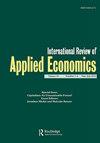传统和数字普惠金融对经济增长的相对影响:基于阈值回归的比较分析
IF 1.6
Q3 ECONOMICS
引用次数: 0
摘要
摘要本研究考察了2014年和2017年130个发达国家和发展中国家传统和数字普惠金融对经济增长的影响。这项研究背后的动机源于一种迫切需要,即不仅要辨别传统和数字普惠金融分别如何影响经济增长,还要比较它们的相对贡献。此外,传统普惠金融和数字普惠金融之间存在潜在的非线性关系,两种形式的普惠金融在一定阈值范围内都能对经济增长产生积极影响。为此,传统金融普惠指数和数字金融普惠指数被作为不同的衡量标准来研究它们对经济增长的相对贡献。采用横断面样本分割和阈值估计分析了数字普惠金融和传统普惠金融在不同水平下对经济增长的影响是否存在差异。这项研究有两个显著的发现。首先,传统普惠金融对经济增长的影响在普惠水平较低的国家尤为明显。第二,在数字普惠金融水平越高的国家,数字普惠金融对经济增长的积极影响越大。关键词:数字普惠金融普惠金融经济增长阈值效应jel分类:G21O4O47C31感谢编辑Jonathan Michie和匿名审稿人提出的建设性意见。披露声明作者未报告潜在的利益冲突。数据和材料的可获得性本研究的数据集作为补充在线资料包含在本文中。附加信息资金作者声明在撰写本文期间未收到任何资金、资助或其他支持。本文章由计算机程序翻译,如有差异,请以英文原文为准。
The relative impact of traditional and digital financial inclusion on economic growth: a threshold regression-based comparative analysis
ABSTRACTThis study examines the effect of traditional and digital financial inclusion on economic growth in 130 developed and developing countries in 2014 and 2017. The motivation behind this study emerges from the critical need to discern not only how traditional and digital financial inclusion individually influence economic growth, but also to compare their relative contributions. In addition, there exists a potential non-linear relationship between traditional and digital financial inclusion, wherein both forms of financial inclusion can exert a positive influence on economic growth up to a specific threshold. For this purpose, traditional and digital financial inclusion indices were developed as distinct measures to investigate the relative contribution of each to economic growth. Cross-sectional sample splitting and threshold estimation were utilised to analyse whether the effects of each financial inclusion index on economic growth varied across different levels of digital and traditional financial inclusion. This study yielded two notable findings. First, the effect of traditional financial inclusion on economic growth is pronounced in countries with low levels of inclusion. Second, digital financial inclusion has a greater positive impact on economic growth in countries with higher levels of digital financial inclusion.KEYWORDS: Digital financial inclusionfinancial inclusioneconomic growththreshold effectJEL CLASSIFICATION: G21O4O47C31 AcknowledgementWe would like to thank the Editor Jonathan Michie and the anonymous referees for their highly constructive comments.Disclosure statementNo potential conflict of interest was reported by the author(s).Availability of data and materialThe dataset of this study is included in this article as Supplemental online materialAdditional informationFundingThe authors declare that no funds, grants, or other support were received during the preparation of this manuscript.
求助全文
通过发布文献求助,成功后即可免费获取论文全文。
去求助
来源期刊

International Review of Applied Economics
ECONOMICS-
CiteScore
4.30
自引率
4.50%
发文量
37
期刊介绍:
International Review of Applied Economics is devoted to the practical applications of economic ideas. Applied economics is widely interpreted to embrace empirical work and the application of economics to the evaluation and development of economic policies. The interaction between empirical work and economic policy is an important feature of the journal. The Journal is peer reviewed and international in scope. Articles that draw lessons from the experience of one country for the benefit of others, or that seek to make cross-country comparisons are particularly welcomed. Contributions which discuss policy issues from theoretical positions neglected in other journals are also encouraged.
 求助内容:
求助内容: 应助结果提醒方式:
应助结果提醒方式:


